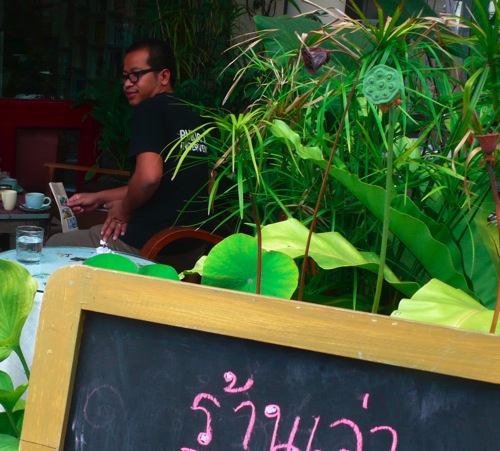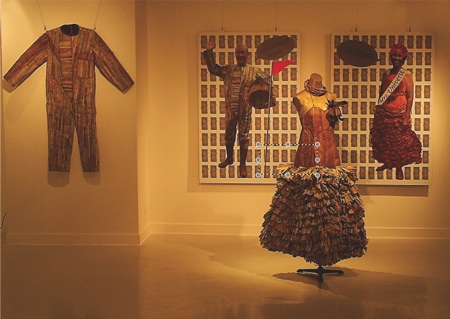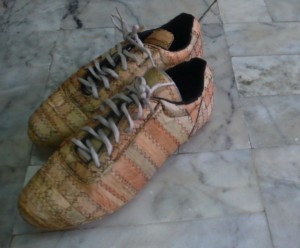
Chakkrit Chimnok at a cafe in Chiang Mai, Thailand. Photo by Paul Schmelzer
Chakkrit Chimnok dreams of a “banana world,” a utopia in which overlooked or discarded items — specifically, the ubiquitous banana leaves that litter the streets in his home city of Chiang Mai, Thailand — can become the material for a renewed world. Chimnok’s recent forays into this idea (or ideal) transformed the ever-present leaves into clothing modeled after western haute-couture.
“One day I was sitting in a banana garden, when a banana leaf fell on me,” he told me last year. He picked it up and felt it: It was smooth and flexible, unlike the dried leaves many locals get rid of by burning. Senses piqued, he began paying attention to how the leaves had different characteristics, depending on where he found them, their age and the level of humidity where they grew.

Installation at Art Space, Japan Foundation, Bangkok. Courtesy of Chakkrit Chimnok
He says he was struck by how perfect banana trees are. Both the fruit and the flowers are edible, and the leaves — as his explorations would later prove — could be made into apparel. Chimnok enrolled in a clothing-design class, taking 60 hours of instruction on sewing and pattern-making, and then set out to make functional objects, including a space suit and a dress (sized for his parents, pictured in the installation shot above), handbags, boots and tennis shoes.

Chakkrit Chimnok, "Body – Imagination – Dried Banana Leaf," 2006. Courtesy of the artist.
This functionality is questionable — as the leaves dry, they become too brittle for regular use — but he appreciates the various layers of symbolism as well. He’s taking gentle jabs at both Thai and western cultures. To often brand-conscious Thai people, he offers fashions from one of the country’s most plentiful, banal and unbranded materials. He patterns his ensembles after western styles, forgoing patongs and flip-flops for western-style skirts and shoes, in order to put the designs both within the vocabulary of fashion but also starkly opposed (the hard, crunchy leaves also stand in contrast to the silk textiles for which Thailand is best known). “We always have the sense that the west looks at us as the third world,” he told me.

Shoes by Chakkrit Chimnok. Photo by Paul Schmelzer.
While his message addresses international audiences — it was featured in the 3rd Fukuoka Asian Art Triennale 2005 and was shortlisted for the 2008 Signature Art Prize by the Singapore Art Museum — it is, in essence, local. In his artist’s statement, he writes, “Following the west is viewed as part of destruction of community culture.” His art is a celebration of the local, he says, even if it celebrates one of that environment’s more overlookable features.
But he’s not Thai-centric about it. During the project’s showing in Fukuoka, Japan, he promoted a local variation of recycling. By the end of his three-month residency, he was showing at a fashion show the 20 kimono-inspired garments he’d created — from bamboo leaves.




Pingback: Gastro-Vision: Aesthetics of Urban Farming, Part I | Art21 Blog